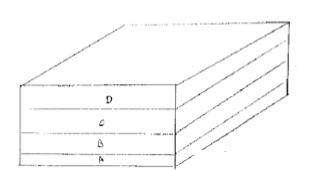Study Guide Page 5
(141).webp)
Explore geological stratigraphy through quiz questions on rock layer dating, effects of faulting, and plate movements. Assess understanding of layer ages and geological processes, enhancing skills in Earth Science.
- 1.
Based on this diagram above, what is the newest rock layer here? (study guide question #14)
- A.
Layer A
- B.
Layer B
- C.
Layer C
- D.
Layer D
Correct Answer
D. Layer DExplanation
Layer D is the newest rock layer because it is on top of all the other layers. In the diagram, layers A, B, and C are all below layer D, indicating that they were formed before layer D. Therefore, layer D is the most recent addition to the rock layers.Rate this question:
-
- 2.
Based on this diagram, which is the oldest layer? (study guide question #15)
- A.
Layer A
- B.
Layer B
- C.
Layer C
- D.
Layer D
Correct Answer
A. Layer AExplanation
The oldest layer is layer A because it is the deepest layer in the diagram. In geological processes, the layers of sedimentary rock are deposited over time, with the oldest layers being at the bottom. Therefore, layer A, being the deepest, would have been formed first, making it the oldest layer.Rate this question:
-
- 3.
When the movements of paltes get involved (in this case, a faulting boundary), the crust might look like this. Here, a fault forced a layer of older rock over a layer of younger rock, and weathering wore away most of the older rock. Now that our rock layers have changed, which layer is the newest? (study guide question #16)
- A.
Layer A
- B.
Layer B
- C.
Layer C
- D.
Layer D
Correct Answer
D. Layer DExplanation
The explanation for the correct answer, layer D, is that it is the newest layer because it is on top of the other layers. The faulting boundary caused layer D to be forced over the other layers, indicating that it is the most recent layer to have been deposited.Rate this question:
-
- 4.
Based on this same diagram, is the newest rock layer still on the top? (study guide question #17)
- A.
Yes
- B.
No
Correct Answer
B. NoExplanation
The newest rock layer has been faulted to the side instead of staying on the top layer.Rate this question:
-
- 5.
In this case, the plates were folded and compressed from a convergent plate boundary. Weathering wore away most of the newest rock. Which layer is the newest here? (study guide question #18)
- A.
Layer A
- B.
Layer B
- C.
Layer C
- D.
Layer D
- E.
Layer E
- F.
Layer F
Correct Answer
D. Layer DExplanation
Layer D is the newest layer because it is located on top of all the other layers. The question states that weathering wore away most of the newest rock, indicating that the layers below layer D are older. Additionally, the plates were folded and compressed from a convergent plate boundary, suggesting that the layers were formed through tectonic activity over time. Therefore, layer D is the most recent layer to have been deposited.Rate this question:
-
- 6.
In this diagram, layer D is the newest. Is this layer still on top? (study guide question #19)
- A.
Yes
- B.
No
Correct Answer
A. YesExplanation
Layer C and B may still be showing, but this is only because weathering wore the surface down to these layers. D is still the newest.Rate this question:
-
Quiz Review Timeline +
Our quizzes are rigorously reviewed, monitored and continuously updated by our expert board to maintain accuracy, relevance, and timeliness.
-
Current Version
-
Nov 20, 2023Quiz Edited by
ProProfs Editorial Team -
Feb 08, 2011Quiz Created by
Farquhkk
 Back to top
Back to top






